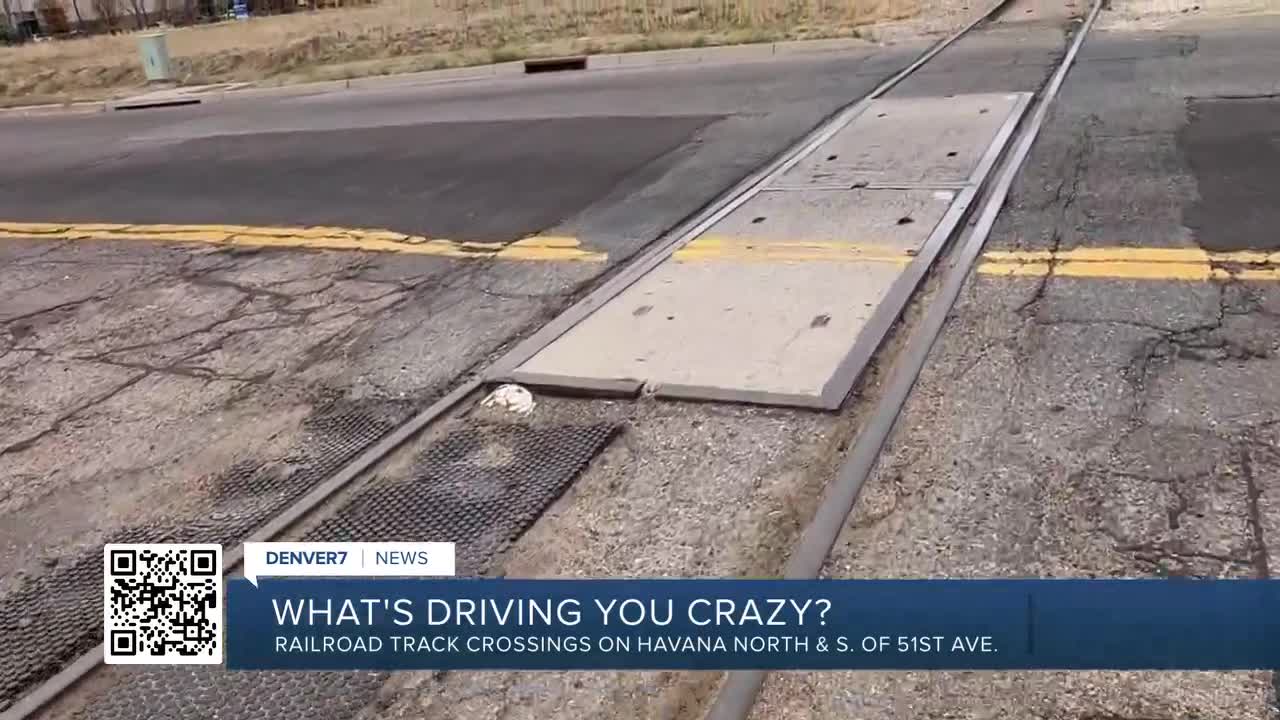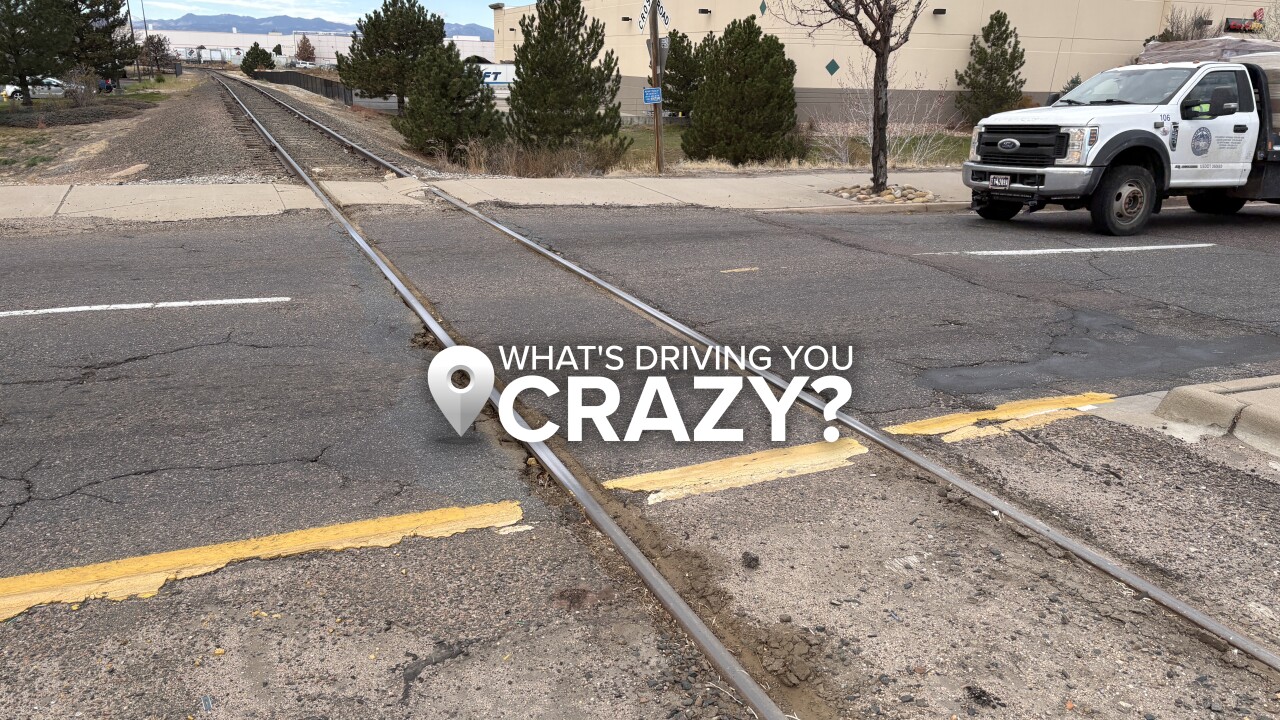DENVER — Daniel from Denver writes, “What's driving you crazy? Railroad track crossings on Havana St. (both directions) North and South of E 51st. Ave. Union Pacific is a complete dumpster fire who will never do anything. Both rail lines are never used and likely abandoned. The crossings are in horrible condition. The City and County of Denver refuses to repair numerous major potholes that are outside of the track and are within their legal responsibility.”
Rough railroad crossings are very annoying, especially if you come across a particularly bumpy or potholed one that you are not expecting. The majority of wear and tear at a crossing comes from constant vehicle traffic, exacerbated by heavy vehicles like trucks which are in abundance on Havana Street in this area. It doesn’t help the situation when snow plows scrape already loose pavement at the crossing.
When I went out there to take a look at both crossings, my first interaction was driving over them. I had to slow down to maybe 20 mph as the crossings looked very uneven. Then when I walked next to them, I saw some significant pothole-like gaps between the pavement and tracks, a few old rail ties sticking out of the ground, one part of the sidewalk that was heaving and cracking and some dips on either side of the crossings. It was also very noisy as I saw lots of heavy trucks going across the tracks adding to the extensive wear and tear.
MORE: Read more traffic issues driving people crazy
It also appeared to me that the tracks were not being used. Union Pacific representatives told me the tracks do still serve several businesses in this area, typically operating overnight. That can be especially dangerous for drivers, as there are no warning lights nor crossing arms that would block traffic when a train is on the tracks when it is dark.
I contacted both the City of Denver and Union Pacific Railroad. I was told there is relief coming but not until sometime in the spring of 2026. I was told these repairs can’t be done sooner as the asphalt can only be set after winter when the frost is gone and when the ambient air temperature is warm enough for the asphalt to cure properly. The work, when it happens, would take about five days to complete.
Union Pacific told me the part of the road that leads up to the tracks and the rail ties would all be replaced.
The city told me the pothole patching team make repairs in October, but would come out to inspect the area again. The city also assured me they would continue to monitor both crossings until the permanent repairs are made next spring. I saw some of those patches but I also saw some significant gaps between the tracks and pavement.
One of the reasons you see so many crossings in disrepair is the high cost to make those repairs. I talked to Senior Manager with Union Pacific Corporate Communications Mike Jaixen and he provided me with a stunning figure. He said the railroad invests about $10 million into their railroad infrastructure, such as railroad crossings, every day. I followed up, asking him to double check that figure.
“We don’t have a breakout for crossings specifically, but our 2025 capital plan is $3.4 billion. Roughly half is for things like rail, ties and crossings. Railroads have to fund all of their own infrastructure,” Jaixen said.
Another reason we see crossings in disrepair is from previous fights between railroad companies and local governments as to who is responsible for repairs and maintenance. That was one of the reasons the Colorado legislature created the Railroad Crossing Maintenance Cost Allocation Act earlier this year. It's a law that states the total cost of maintaining an existing crossing shall be shared equally between the railroad and the local road authority. The law requires the Public Utilities Commission to create rules that split the cost of crossing maintenance equally between railroads and other road authorities. If the applicable road authority is a local government, like the City of Denver in this case, the commission must adopt rules that require the total costs to be apportioned as follows:
- The railroad is responsible for the costs to maintain the portion of the existing railroad crossing that is between the ends of the railroad ties; and
- The local government is responsible for the costs to maintain the portion of the existing railroad crossing that is outside of the ends of the railroad ties.
How this new law will increase the number of crossing repairs is yet to be seen.
Union Pacific told me, if you believe the crossing caused damage to your vehicle, you should reach out to their claims team at 877-877-2567, option 1.
Denver7 Traffic Expert Jayson Luber says he has been covering Denver-metro traffic since Ben-Hur was driving a chariot. (We believe the actual number is over 25 years.) He's obsessed with letting viewers know what's happening on their drive and the best way to avoid the problems that spring up. Follow him on Facebook, Twitter or Instagram or listen to his award winning Driving You Crazy podcast on any podcast app including iTunes, iHeartRadio, Spotify, Podbean, or YouTube.
WHAT'S DRIVING YOU CRAZY? DENVER7'S JAYSON LUBER ANSWERS YOUR QUESTIONS.
-

Are Red Rocks College police setting up speed trap on W. 6th Ave. Frontage Rd.?
-

The ramp from 84th Ave. to south I-25 has a sign that doesn’t seem correct
-

What are the different colors on the tolling signal on the I-25 express lanes?
-

Does CDOT really use the variable speed signs I see on I-70 in the mountains?
-

Driving You Crazy: What's with the poles along Wadsworth between 35th and 36th?





